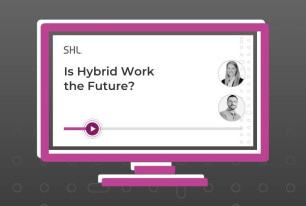How to Make Remote Working Feel Normal in Not Normal Times
Embracing remote working is more than importing physical office habits into virtual environments – Working asynchronously may be the key.
Share
“It was a bright cold day in April, and the clocks were striking thirteen”. Using the bank holiday weekend for a clear-out and to tidy my office, I chanced upon an old copy of 1984 that has survived many previous clear-outs. Orwell’s chilling opening line beautifully combines a description of normality with an ominous hint that this isn’t a normal time.
Today is a bright(ish), cold(ish) day in April and, while the clocks weren’t striking thirteen, this isn’t a normal time. We, like many organizations — fighting to adapt, have run headfirst into full-scale remote working environments and have not had time to do more than import normal working practices into a virtual setting.
SHL’s research identifies three employee capabilities critical to their success as remote workers. Their focus on self-development and well-being, how they continue to communicate and build work relationships, and their broader work habits.
I was reminded of this while listening to a podcast with Matt Mullenweg, CEO of WordPress. He created and leads a company that employs 1,100 people, all based remotely (which he describes as “distributed” because remote suggests there is a central location).
Matt described the real value of remote working as a way of providing both purpose and autonomy to employees. He describes five levels of how organizations approach this different way of working:
Level 1: Waiting to get back to the office. Working from home is rare, and although possible, is not expected for more than a day. Many things are put off until employees are back at their desks.
Level 2: All meetings and communications take place remotely using Zoom or Teams. Companies are simply replicating existing habits from the office – good and bad.
Level 3: Meeting culture and communications are designed to optimize remote environments. Meetings aren’t used to communicate messages; they are for decision-making. Communications take place through text-based channels. Unless necessary, meetings are smaller, shorter (two people, fifteen minutes) and use collaborative technology (such as Google Docs) as a focus to ensure shared understanding and outcomes.
Meeting culture and communications are designed to optimize remote environments.
Level 4: Adopting an asynchronous approach. Teams operate as if people work in different time zones. This requires more communication, generally written, all of which is available to all people whether they attend a meeting or not. Real-time (synchronous) meetings are kept to a minimum, allowing people to really reflect on their responses to work and decisions. This improves the quality of work and harnesses insight from the whole team, not just those likely to lead meetings. Employees set their own patterns and work is evaluated based on work produced, rather than just how and when it was delivered.
Level 5: Perhaps unattainable, but where employees working asynchronously, feel empowered by the trust and autonomy provided and are able to build work schedules that support individual productivity as well as space for mental and physical wellness, and bring higher levels of engagement, creativity, and passion to their work.
The shift through levels 1-3 are about organizations adapting to remote working, but levels 4 and 5 are about organizations embracing this new way of working through asynchronous working. This, Mullenweg concludes, results in improvements to efficiency, productivity, and engagement beyond what is possible in a normal office environment.
Mullenweg makes a convincing case and thinking about how our team benchmarks is interesting. We should be comfortably at level 3 or 4. Our team of consultants is used to working remotely and often complete their work asynchronously – passing detailed briefings with time requirements to move their work and projects forward. However, a quick look at my diary for next week paints a different picture. It is completely stacked with meetings… team updates, weekly project internal and client calls, 1:1s with each direct report and my manager, team meetings, new product training… the list goes on. All default one hour, almost all with five or more attendees.
While we are all adapting to lockdown conditions, many of us are juggling work schedules with partners, fighting for broadband with flat-mates, homeschooling children. We are effectively working on different time zones. The need for us to work asynchronously has never been greater. We have the opportunity to think differently – not just adapt to — but embrace this not normal time.
So I’ve developed 3 ways I plan to help my team move to higher levels of remote working:
- Improve Efficiency and Productivity by Rationalizing Meeting Time
If updates can be done beforehand and decisions can be made afterward, then you don’t need as much time in the meeting itself. - Don’t Work Alone. Collaboration Is Still Critical
Where you want to brainstorm or discuss problems – you have the whole remote team to reach out to rather just those in the office that day. - Use Centralized Communications
Use centralized communications that your team can access anytime that essentially become your virtual office hub. This is where anyone can go to see priorities, documents, and updates.
I am committed to helping my team make the most out of not physically being around each other as we grow in efficiency in our meetings and build collaborative relationships with team members that we do not see every day in the office. What can you do that would improve the well-being of your team working from home that you cannot do in an office?
To find out more ways to grow in effectiveness as a remote worker – explore SHL’s new RemoteWorkQ! Our newest and most revolutionary assessment that identifies the strengths, areas for development and need for support as you and your teamwork remotely.









